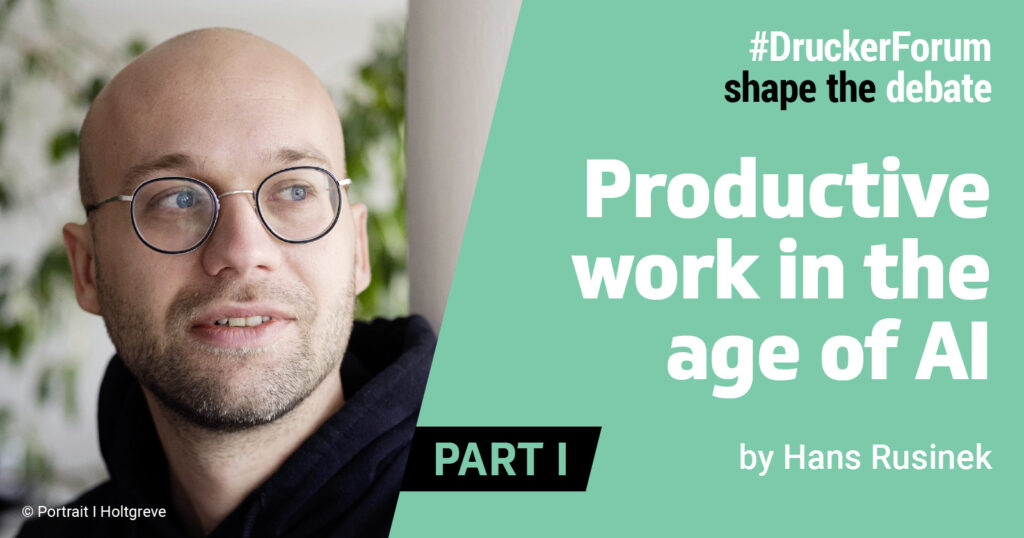
The story of productivity in industrialized countries started as a story of huge successes and then turned into one of equally huge disappointments. Up until the 2000s work productivity still grew with an annual mean of 2,5%. Since then it began to stall around 1,1%. Why?
Peter Drucker mused that today’s corporations would only need half as many hierarchical layers and only a third of the managers that firms in the 1980s had. We couldn’t be further away from fulfilling this. Bureaucracy is virulent especially in large firms that dominate today’s economy: More than a third of US employees work in firms with more than 5000 employees, where its frontline employees are buried under an average of 8 management layers. Numbers in Europe are even more dramatic: In some of the large firms I work with, the ratio between white collar and blue collar is strongly tilted towards the first group, even industrial companies. Some German automotive companies have more white than blue collar workers. Especially when considering the technological advances since the 2000s, productivity growth has been very meagre. Technological advances have not compensated for managerial shortcomings.
Will AI lead us out of the productivity debacle?
Hopes are tied to the advance of artificial intelligence. AI will change the workplace, there is no doubt. But how will AI make our workplace more productive?
The future of AI is often compared to the innovation path that the internet took, or even further back, the railway. Rarely, however, AI is compared with the invention of the telegraph. In an article in the Economist, mathematician and historian Andrew Odlyzko[1] argues that the latter comparison is much more insightful and the comparisons with the internet and the railway are quite misguided.
Railway companies as well as telecoms pioneers knew from the start where productivity growth is coming from, and where the money will be made: In the first case old and cumbersome modes of transport were replaced, in the other case it was old and cumbersome forms of communication. More efficient mobility through trains or more efficient communication through e-mails undoubtedly led to more productivity.
Productivity in the 21st century means solving the most urgent problems
Studying the history of the telegraph is more insightful because it mirrors how large tech companies approach AI today. In the beginning telegraphs were overwhelmingly used by rail companies to help make trains run more smoothly. Railway tycoons monopolized that technology and built telegraph networks alongside their rails so that communication of track disruption could be made quickly. Their massive investments in the telegraph led to price wars, as they tried to use the technology to protect their business models. Equally today tech giants are using AI as co-pilots in existing cloud-offerings, argues Odlyzko.
With today’s AI applications nobody knows yet where significant and lasting productivity boosts across sectors and specific use cases will come from. Nobody knows its killer app. Nobody knows where huge sums of money to justify its current hype could be generated. This is why we need an open and purposeful culture of experimentation in the workplace.
The real boom of the telegraph came much later, when more ambitious, dynamic and independent companies built business models around the new technology alone and created a much more holistic and productive market for using telegraphs beyond the railway network.
Coming back to the present, this analogy can help us to ask better questions for our organisation:
- If AI is the answer, what is the question?
- Which productivity problem is AI supposed to solve (formulating an email in the style of Shakespeare or creating images of unicorns and rainbows is not an urgent issue)?
- What is keeping your organisation from becoming more productive? Are we really looking at technological problems, or rather managerial problems?
- What routines would employees wish to see automated to really be able to get more done?
These questions might help to bring the hype around AI from promise to profit.
Intelligence that is artificial vs. intelligence that is human
Working more productively with AI might start with overcoming what we call it in the first place: artificial intelligence. There is nothing artificial about it. It’s all human-made, which we can already see by the ways biases are baked into the human-made data that LLMs use. It is not intelligent, nor does it aim to be intelligent in the way humans can be intelligent, i.e. empathetic, moral, purpose-driven, problem-solving. In that sense, GenAI might offer intelligent sounding answers but it never really understood the question. Researchers in the field therefore call for using “mechanical utility”, or “stochastic communication” as more helpful terms. Because that would help us to find renewed appreciation for another form of intelligence, too. Call it HI, Human Intelligence.
About the author:
The economist and philosopher Dr. Hans Rusinek teaches at the University of St. Gallen on the future of work, works as an independent management consultant and is a Fellow of the Club of Rome Germany. Prior to that, he worked at the Boston Consulting Group.
[1] https://www.economist.com/business/2024/08/06/a-history-lovers-guide-to-the-market-panic-over-ai

